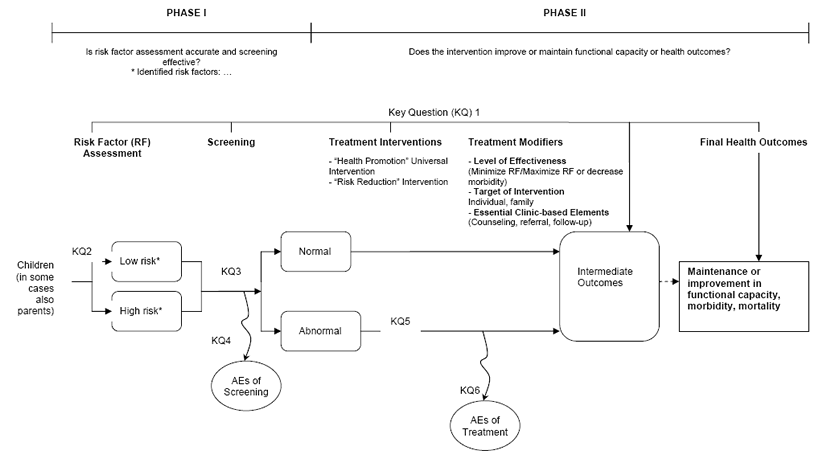The USPSTF has developed a new way of approaching the evidence on preventive services for children and adolescents. Its new analytic framework takes into consideration several important issues in child and adolescent health:
- Developmental trajectories—keeping children on the most advantageous path as they grow and develop.
- The influences of family and other caregivers on child and adolescent health decisions and outcomes.
- Building the chain of evidence to support clinical preventive services recommendations.

This flowchart serves the dual purpose of identifying questions to help structure the literature review and of providing an "evidence map" after the review for the purpose of identifying gaps and weaknesses in the evidence.
In Phase I, USPSTF members consider whether the risk factor assessment is accurate and screening is effective. In Phase II, USPSTF members consider whether the intervention works to maintain or improve health.
The population that is the focus of the evidence for a specific preventive service appears at the left-hand margin of the diagram. Actions, such as screening (for example, identifying low- and high-risk populations, or recording normal and abnormal test results) and treatment, appear as arrows linking the population to an outcome. A curved arrow leads to adverse effects of the action. Each arrow is a linkage in the logical chain of evidence that connects the left side (population) and the right side (health outcomes) of the analytic framework. Intermediate and health outcomes are depicted by rectangles.
Key Questions:
- Is screening for X associated with improved health outcomes?
- Can a group at increased risk for X be accurately and reliably identified?
- Are there accurate (i.e., sensitive and specific) screening tests available?
- What are the harms of the screening test?
- Are effective treatments available that make a difference in intermediate outcomes when the disease is caught early, or detected by screening?
- What are the harms of the treatment?
- How strong is the association between the intermediate outcomes and final health outcomes?
Current as of: February 2014
Internet Citation: USPSTF Analytic Framework for Child and Adolescent Health Topics. U.S. Preventive Services Task Force. October 2017.
